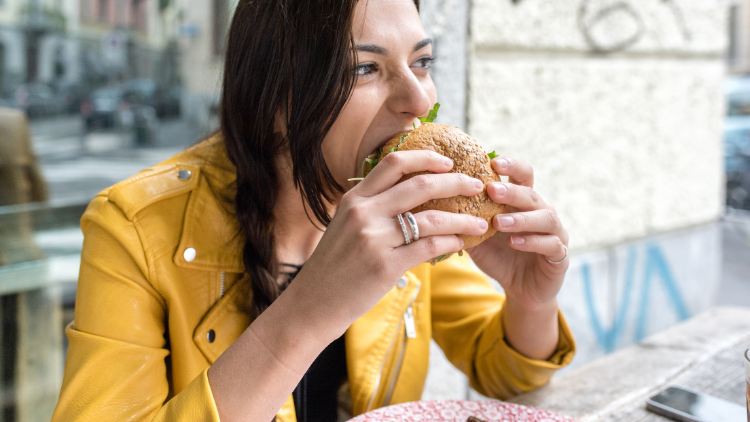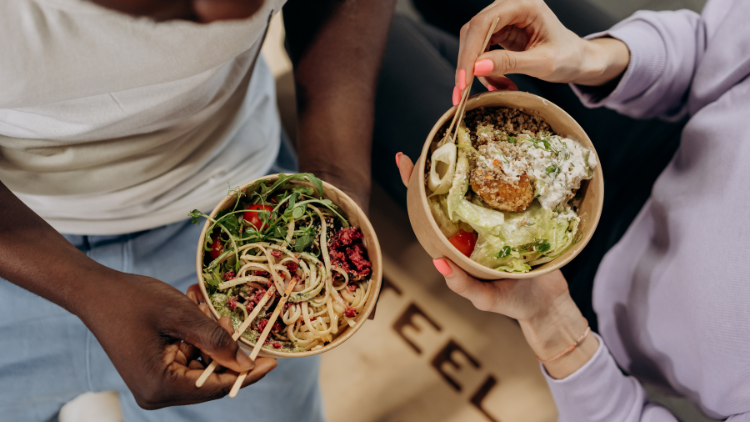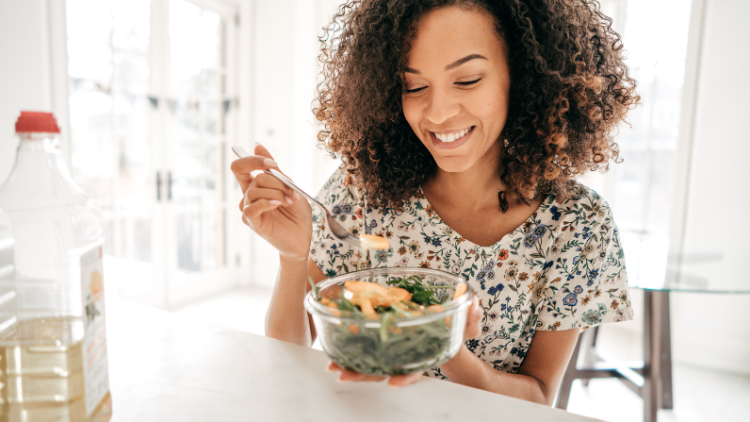Intuitive eating is growing in popularity due to the “food freedom” and body liberation connotations it carries with it. As it grows in popularity, the intuitive eating reviews and critiques are rolling in.
While some concerns are valid, others are misguided. Some aren’t sure how it could be possible, and others are unsure of how intuitive eating is different from not dieting, or even reverse dieting. Keep reading for everything you need to know about intuitive eating and see if it’s the next step for you.
Basics of Intuitive Eating
To answer the question, “what is intuitive eating?” we first need to understand what mindful eating is.
Mindful eating is about having increased awareness around the foods being chosen, internal and external physical cues, and your responses to those cues. We determine our responses by noticing bodily sensations, thoughts and feelings around the food, and not passing judgment around the eating experience.
The goal of mindful eating is to promote a more enjoyable meal experience and a better understanding of the eating environment. It is supposed to help guide us with what to eat, why we eat what we eat, how much to eat, and how to eat.
Using the constructs from mindful eating, two registered dietitians developed the 10 principles of intuitive eating (more on this below) with the addition of an uninhibited, non-diet approach to health, nutrition and body acceptance. Their goal was that it would be a compassionate self-care eating framework that treats all bodies with dignity and respect.
This anti-diet approach has been proposed as the solution to healing the chronic dieter’s relationship with food, and potentially even as a tool in eating disorder treatment.
What Does Intuitive Eating Mean?
Intuitive eating means listening to internal cues such as hunger and fullness rather than relying on external cues such as calories, a diet plan, or the time of day. It also means approaching your nutrition from a non-judgmental place and not beating yourself up for having foods that diet/wellness culture deems as “unhealthy.”
History of Intuitive Eating
Intuitive eating was coined by 2 registered dietitians, Evelyn Tribole and Elyse Resch. After working in private practice with eating disorders and also counseling clients in weight management, they noticed that their clients continued to regain the weight they had lost from following traditional weight loss methods.
They started to feel a desire to help their clients in a different way – a way that created a positive, non-stressful relationship with food and moved away from the dieting mentality. Not only did they want this to help their weight management clients, but they hoped it would help with their eating disorder clients as well and potentially prevent the onset of eating disorders.
Is Intuitive Eating a Diet?
Intuitive eating is not a diet. The 2 biggest differences between a diet and intuitive eating are:
- Intuitive eating is not intended for intentionally losing weight.
- Intuitive eating does not make any foods off-limits, or deem any foods as “bad”.
What Do You Eat With Intuitive Eating?
While most diets will have a list of approved foods and off-limits foods, intuitive eating flips the typical dieting mindset upside down and invites you to not restrict any foods. Rather, the idea is to choose a variety of foods that make you feel good physically and mentally.
Confused? I get it. Let me see if I can clear things up for you and show you how to begin intuitive eating.

How to Eat Intuitively
Intuitive eating has 10 principles in total. These principles all work together to help create a healthy, sustainable, easy relationship with food that (should) improve both physical and mental health.
I’ll list all 10 here, but we won’t be discussing all 10 of them in depth today.
The Principles of Intuitive Eating
- Reject the Diet Mentality
- Honor Your Hunger
- Make Peace with Food
- Challenge the Food Police
- Discover the Satisfaction Factor
- Feel Your Fullness
- Cope with Your Emotions with Kindness
- Respect Your Body
- Movement—Feel the Difference
- Honor Your Health—Gentle Nutrition
I do want to touch on a few of them in a little more detail.
Reject diets
One of the biggest barriers to being an intuitive eater is if you’re still stuck on the diet train. It’s impossible to follow the rest of the principles if we are letting a cookie-cutter meal plan, meal replacement system, or Instagram influencer tell you how to eat.
So step #1: ditch the shakes, the calorie counters, the food scale, the WW app, and break free baby.
Eat when you’re hungry
A natural question after ditching all the things that tell you what and how much to eat is, “Okay so how will I know when to eat?”
This is where it gets fun. Instead of torturing yourself and trying to resist any feelings of hunger, you get to actually eat when you’re hungry. But hang on – what if you don’t feel hunger cues anymore?
Oftentimes what happens after years (or for some, decades) of dieting is that hunger signals are no longer working properly. This makes intuitive eating really difficult for those who just see it as the “eat when you’re hungry, stop when you’re full” diet.
This is why I need to remind you that it’s not supposed to be a diet, but a framework. Frameworks are supposed to be loose, which means if you don’t feel hungry you aren’t doing intuitive eating “wrong”. What it does mean is that you need some help to reinstate those signals, which a Registered Dietitian (RD/RDN) can help you with.
Intuitive eating also isn’t about only eating when you’re physically hungry. There are some other instances where eating is warranted.
For example, if you aren’t feeling hungry at the moment but won’t have another opportunity to eat for 6 hours, intuitive eating encourages someone to be logical about that and go ahead and eat. Considering they won’t have the opportunity to fuel themselves again for 6 hours, eating something now is a way to honor and respect the body.
Eat to fullness
For intuitive eaters, the idea is not only to honor your hunger and give the body food when it’s asking for it, but also stop when it’s signaling that it’s had enough. This is, of course, the sensation of fullness.
Many people have a hard time feeling full unless they are completely overstuffed. Slowing down and paying more attention to the eating experience can help to find those earlier feelings of fullness. This takes practice, and can ultimately be really hard to master if you are still dieting and fear that fullness at all means you’ve eaten too much.
Many intuitive eating critics suggest there is not enough emphasis on healthy eating. In my experience, however, this depends on the person teaching it. The 10th principle of intuitive eating actually does encourage healthy eating, and this principle is called “Gentle Nutrition”.
Gentle Nutrition
Gentle nutrition is intuitive eating’s way of reminding you that yes – nutrition does matter. It does have some impact on your health. It can help you feel better. We do need to keep certain things in mind. Having ice cream every day for breakfast, lunch, and dinner is not a great idea.
A driving point for intuitive eating is to have theoretically come to this realization on your own; If you truly listen to your body (and how you feel after eating certain things in certain amounts), you’d find that having only ice cream doesn’t ultimately make you feel 10/10.
This is where I think the instructor of intuitive eating needs to be okay with some general nutrition education where it seems necessary. Some won’t intuitively pick up on things that are ultimately going to serve them more, others will.
Whoever is instructing you in an intuitive style of eating is responsible for helping you navigate healthy decisions without making them into hard-and-fast rules. We still need to generally educate the public on things that overall contribute to better health and a lower risk of chronic disease, but we can do this in a way that still allows for people to enjoy life and find food satisfying, enjoyable, and fun.
Intuitive Eating and Exercise
Intuitive eating’s 9th principle creates conversation for something else vitally important for health and wellbeing: exercise. Tribole and Resch refer to exercise as “movement” – a simple language switch that many individuals find helpful for creating a healthy relationship with fitness. Many find exercise to remind them of their dieting past and have used exercise as a form of punishment, rather than a celebration of what the body can do.
Movement helps take the pressure off of having a workout that’s “worth it” and the mentality of “no pain no gain”. What this ultimately does is encourage more people to move their body more, rather than shying away from it because “exercise is hard and I don’t like it”.

Stages of Intuitive Eating
Being an intuitive eater isn’t necessarily something you can just wake up one day and decide to start doing. I mean, you can, but that doesn’t mean you’ll knock it out of the park on day 1. Intuitive eating is a process, and with processes come different stages. Let’s talk through the stages as Tribole and Resch discuss in their book.
Readiness
The first stage of intuitive eating involves hitting diet rock bottom. Most women I’ve talked with aren’t looking for a completely different approach unless they are exhausted, drained, and defeated from decades of another approach. It’s unfortunate, but kind of a necessary step in the process.
Exploration
This is where we start to discover all the things about yourself that dieting held you back from: how you’re feeling, what you actually like to eat, what makes you (as an individual) feel good, what your biology is telling you, and more.
The exploration phase involves hyper-awareness so we can truly learn what we need to know about what makes you… well, you.
Crystallization
This is where the conscious shifts into subconscious, and what used to take active energy and hyper-awareness now becomes second nature. Food doesn’t feel like a threat, your brain is quiet, and you’re able to separate emotional eating from physical hunger.
Intuitive Eater Awakening
This is where it all comes together and your new skills are working in constant harmony, creating a symphony of choosing nutrient-dense foods while still enjoying fun, energy-dense foods in moderation. You crave moving your body, and no longer feel a pang of guilt every 5 minutes for remembering how you look or what you ate last week. You’re able to make nourishing choices while being free from the food-related stress that diet culture has bogged you down with.
Why Intuitive Eating Works
Intuitive eating is a game changer for many people because frankly: we’re tired. We’re tired of obsessing over food, our weight, and we want to just enjoy our lives.
The main idea behind intuitive eating is that, well… It’s intuitive. Therefore, we all are born with the innate ability to be intuitive eaters. This is a huge reason why it works – it’s not something you need to learn, but rather something that you need to relearn.
With its positive and encouraging approach to healthy behaviors like slowing down when you eat, moving your body, stopping when full, and dealing with emotions properly – this framework is full of health-promoting principles.
But what if you can’t seem to get the hang of intuitive eating? Are there people who intuitive eating is contraindicated for?
When Intuitive Eating Doesn’t Work
Some individuals struggle with the “intuitive” part of intuitive eating, and find it hard to notice hunger and fullness. This could be due to something called hypoleptinemia – or low levels of leptin, the hormone that is responsible for signaling fullness. There is some emerging literature suggesting that individuals with obesity struggle with this.
There’s also a reality of ultra-processed foods being highly palatable, making them generally more desirable. Even though eating in a way that makes you feel physically good won’t necessarily mean eating ultra-processed foods all the time, many struggle with hanging on too closely to what will make them feel mentally good. While this is indeed an important part of intuitive eating, there should also be a conscious awareness of nutritional context and a desire to fuel the body in nourishing ways, while still incorporating the foods that are extra fun in moderation.
As a final note, some find the “gates wide open” approach of intuitive eating completely paralyzing and do better with structure. Others need to track their calories to be sure they’re eating enough, or to gather a general idea of the calorie and/or macro content of foods.
Intuitive eating won’t necessarily be the most sensible thing for everyone, and that’s okay.
Intuitive eating is also likely not wise for someone struggling with a medical condition that requires a high level of dietary supervision such as chronic kidney disease, anorexia nervosa, etc.
However, intuitive eating is shown to be helpful for those struggling with an all-or-nothing relationship with food (which is the population I work with). To learn more about the benefits these individuals can experience, keep reading.

Health Benefits of Intuitive Eating
In my personal and professional experience, when intuitive eating is done right there are a lot of benefits. Women I’ve worked with report a drastic decrease and/or complete cessation in binge eating, lower instances of emotional eating, better sleep, better mood, more energy, muscle growth, lower HgA1c, improved cholesterol levels, and more.
But beyond my little pocket of the world, what does the research say?
Reduced disordered eating and better mental health
A meta analysis reviewing 97 studies showed that intuitive eating reduced eating pathology, body image disturbances, and psychopathology. Intuitive eating was positively associated with numerous positive psychological constructs, such as positive body image, self-esteem, and well-being.
More attuned to hunger and fullness cues
Intuitive eating (and mindful eating) both encourage an awareness of hunger and fullness cues. For many individuals, these cues have been tossed to the wayside and deemed “unimportant”. However, these cues are the body’s natural way of regulating food intake to meet energy needs. Without them, we would need to dive deep into calories, macros, and portions.
The tricky part for many with intuitive eating is that they do not feel these cues anymore, or they only do when they feel extreme hunger or extreme fullness. Working with a registered dietitian to restore a normalized eating pattern can restore missing cues, opening up the opportunity to eat in a more intuitive way.
Improved digestion
After periods of yo-yo dieting, it is common for individuals to report having issues with their gut health. This may even lead them to try more diets as they try to fix the gut health issues with more restriction. However, in many cases, it is the dieting itself that has created some unrest in the gut.
The gut microbiome thrives the most when it has a variety of carbohydrates – which is often the first thing to go when someone is trying to lose weight and goes on a diet. When all foods are allowed back into the diet (with the exception of any known allergens) then the gut microbiome is able to restore its balance and digestion/gut health improves.
Lower BMI
It has also been suggested that intuitive eating is associated with a lower BMI. In this review article looking at 26 articles, researchers found that there were consistent associations between intuitive eating and a lower BMI and better psychological health.
Can You Lose Weight Eating Intuitively?
Intuitive eating is wonderful for healing a broken relationship with food/self, but what if you are carrying around extra weight that you would like to lose?
This is a tricky topic because the focus of intuitive eating is not weight loss, but it doesn’t discourage unintentional weight loss either. Where it gets heated is when someone wants to eat intuitively AND intentionally lose weight – that’s where all the intuitive eating and Health At Every Size people lose their minds.
With traditional/true intuitive eating, the goal is not weight loss, and intentional weight loss is discouraged.
I’m a little bit on the fringe of the intuitive eating space and would actually like to support people with their fat loss goals – as long as it’s within reason, they’re realistic, and they are fully aware of the risks… AND as long as they take some time off of actually focusing on fat loss and focus on the things that facilitate health instead. 😉 With all that in mind, I’m totally fine with people having fat loss goals. Let’s just be smart about it, or avoid it completely if it personally sends you into a tailspin of horror.
Can Intuitive Eating Help with Binge Eating?
Intuitive eating is quickly growing in popularity as a solution for binge eating and overeating. However, intuitive eating in isolation is likely not enough to help someone move past binge eating struggles. This is why I personally incorporate more than just intuitive eating into the work I do with my clients struggling with binge eating.
Cognitive behavioral therapy, whether formal or self-guided, has some incredible results for binge eating / binge eating disorder and is assigned as grade A treatment. This is why I personally find that intuitive eating alone is not enough for binge eating, and there needs to be some mindset work as well.

How to Get Started with Intuitive Eating
If you’ve decided intuitive eating is the next step for you, but you aren’t sure where to go from here – keep reading for how to start intuitive eating.
Start Learning About Intuitive Eating
You’ll want to snag a copy of intuitive eating so that you can properly learn all 10 principles. I also recommend listening to Nourished & Free: The Podcast to get some additional insight into topics brought up inside of the book.
Get Rid of Diet Books and Other Diet Resources
In your quest to become an intuitive eater, it’s extremely important to approach it from as much of a blank slate as you can. That means getting rid of all the diet books, apps, and other tools used for restricting your food intake. You may also want to consider putting the scale away for a time, if not getting rid of it all together (I personally don’t keep a scale in my home. I know myself and know that it can quickly become an obsession for me. Getting weighed 1-2x a year at the doctor is enough for me!)
Seek Out Support
If there’s one thing that is bound to lead to failure when it comes to intuitive eating, it’s trying to do it all on your own. Intuitive eating is a completely upside-down way of looking at food, nutrition, your body, and health. This is probably exactly what you need – but it can also mean it will confuse you at times.
Find a group of like-minded people who are on a similar journey as you with intuitive eating so you can discuss the process and troubleshoot things together. Even better, seek out professional help and a community (see below).
Get Professional Help from an Intuitive Eating Dietitian
As stated above, intuitive eating is confusing. You’re going to have questions, feel unsure, and maybe even stuck at times. Having a professional walk you through the process is crucial, and even more so having a registered dietitian with a background in eating disorders (such as myself) and a masters in health psychology to make sure your relationship with food and your nutrition choices are best serving you and your health goals in addition to your mindset.
The Final Verdict: Is Intuitive Eating Healthy?
Is intuitive eating really healthy, or just an excuse to eat “junk” food? Honestly, it depends on how it’s interpreted.
This is where having the right teacher becomes really important. Some intuitive eating “coaches” will shout food freedom from the rooftops and never help people with navigating nutritious choices as well. Others will make you feel guilty for wanting to have a salad, claiming you’re being “fatphobic”. Personally, I think there needs to be a balance.
Intuitive eating should still consider health-promoting behaviors including eating health-promoting foods. What happens sometimes is that people turn intuitive eating into just simply “not dieting”.
I talk more about how intuitive eating is different from not dieting in a recent podcast episode, check it out here.

Need Help with Intuitive Eating?
If you’d like to explore a new way of thinking about nutrition without obsessing over it, constantly feeling confused, or feeling like a prisoner to food – I’d love to help. With Nourished & Free®, you get a step-by-step path of how to master intuitive eating with the support of like-minded peers and professionals walking you through each step. In addition to that, we’ll go beyond just intuitive eating and dig more into mindset, food psychology, emotional eating, binge eating, your relationship with exercise, and body image.
To learn more and apply, visit here.
